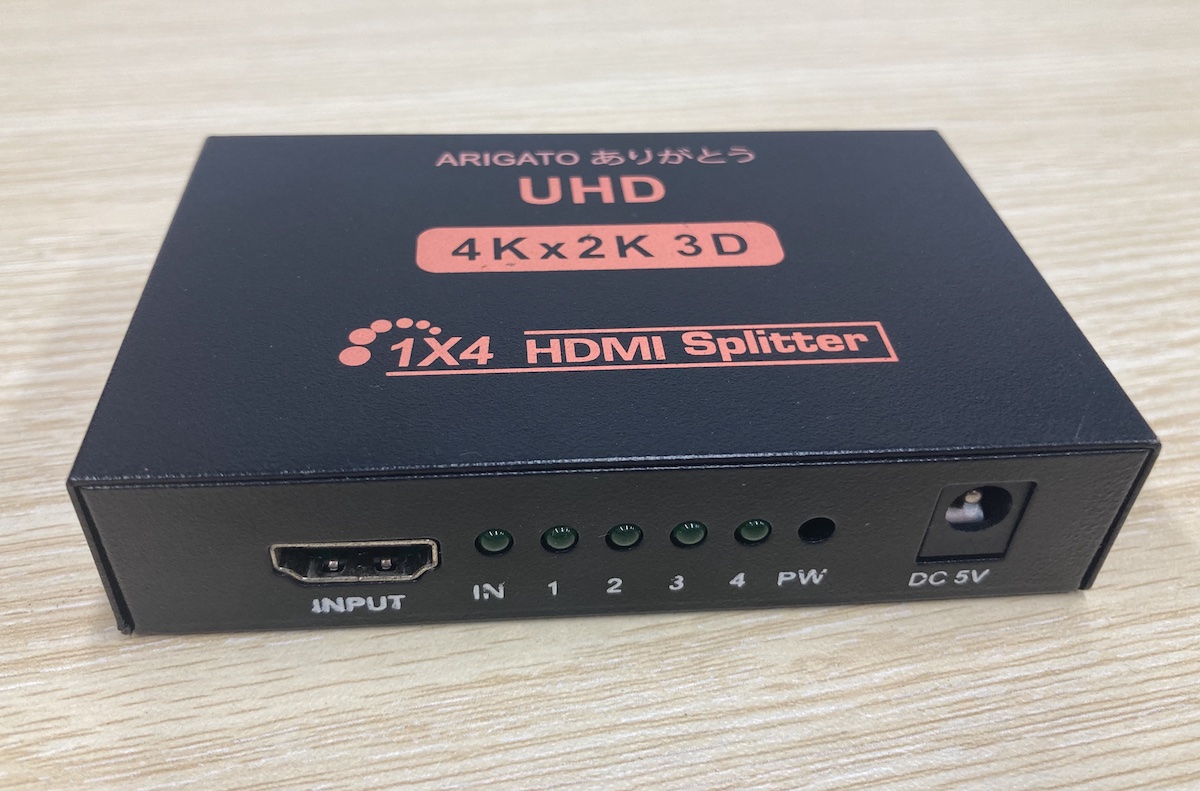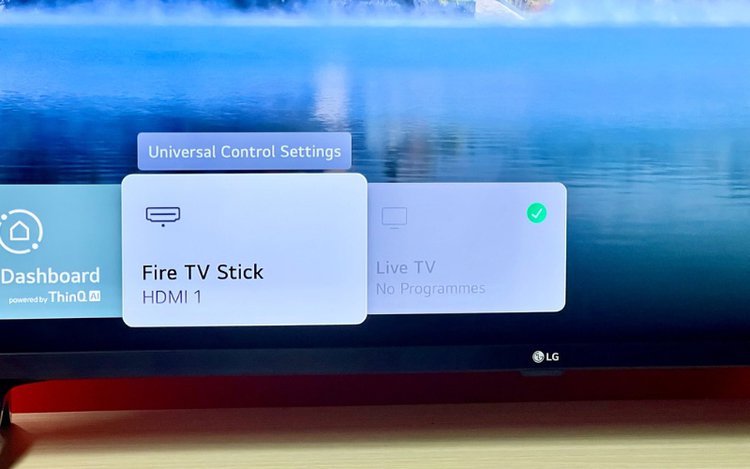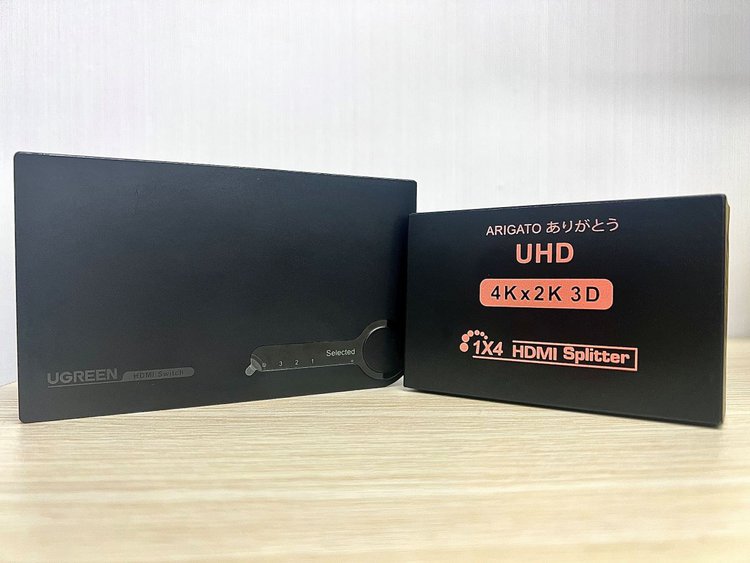7 Proven Ways To Fix “Not Working” HDMI Splitters

What To Know
- Ensure cables are correctly plugged into their designated input and output ports on the HDMI splitter.
- Set your TV to the correct HDMI input that corresponds with the port used by the HDMI splitter.
- Use compatible, high-quality HDMI cables, especially for setups requiring high resolution and refresh rates.
In this article, I’ll provide 7 proven solutions to fix a non-working HDMI splitter.
Keep reading to discover these easy fixes!
Quick Navigation
1. Your Cables are Improperly Plugged into the Wrong Ports
HDMI splitters feature one input port and at least two output ports. This allows you to connect one input source (e.g. your laptop, streaming device, etc) to several outputs (e.g. your TV, projector, etc.)
You must plug your input and output devices into their respective ports for this setup to work, otherwise, the splitter will try to direct your output device’s signal to your input device.
Most splitters will have clear input and output labels directing you where to plug in your devices. So, check if your HDMI splitter has these labels, then plug in your devices accordingly.

Some HDMI splitters may not be labeled. If this is the case for your splitter, find the singular HDMI port on one side of the device. Then, plug your input source into it.
There will then be several ports located on another side of the splitter. These will be your HDMI output ports that you can plug your TV, monitor, AV receiver, etc., into.
Remember, HDMI splitters split one input source’s signal into multiple outputs.
If you’re still confused about how an HDMI splitter’s input and output ports work, refer to this diagram demonstrating some typical HDMI splitter setups.
2. Your TV Is Set to the Wrong Input
Your TV must be set to the same input as your HDMI port. Most TVs do not change input automatically, so you must change it manually.
Ensure it’s not set to another one of your TV’s inputs, such as VGA, Component, or Composite.
Please note that monitors must also be set to the correct input.
If your TV is set to the HDMI input, then it may be set to display another one of your TV’s HDMI ports. Some TVs have multiple HDMI ports, each of them labeled with a number corresponding to the TV’s input. So, if your HDMI splitter is plugged into HDMI 1, you will need to ensure your TV’s input is also set to HDMI 1.

In rare cases, these input sources can be improperly labeled. So, try flipping through all of your TV’s inputs to see if any of them display your input device. Also, make sure your input device is on and properly connected to the splitter, or else your TV will not receive its signal.
You can change most TVs’ input source by repeatedly pressing the remote’s Input or Source until the source name found at the top right corner of the screen matches the HDMI port the splitter is plugged into.
3. The Cables are Incompatible
It’s possible that the HDMI cables you’re using are incompatible with the input or output signal. This is especially common for 4K or 8K setups with high refresh rates that require ultra-high speed, high-quality HDMI cables.
So, if you’re using a cheap or old HDMI cable, you may need to replace it with a high-quality and new model.
The best option is to get an ultra high-speed HDMI cable, like the Zeskit Maya 8K Certified Ultra High-Speed HDMI Cable, that supports all of the available resolutions and refresh rates, ensuring it will be compatible with your input and output sources.
- Cable length: 2m / 6.5ft
- Ultra High Speed HDMI Cable Certified (w/ Hologram Sticker)
- 48Gbps bandwidth for latest features HDR, HDCP 2.2 & 2.3, DTS:X, Dolby Atmos, Dolby Vision
(Paid Link.)
If you’re connecting your computer to the HDMI splitter, you can try adjusting its resolution and refresh rate in its settings.
Let’s learn how to do this on computers with Windows and macOS!
Windows
Step 1: Head to your computer’s Desktop screen and right-click on a blank space. Do not right-click on any of the widgets.
Step 2: Click on Display Settings from the drop-down menu.
Step 3: Head to Advanced Display Settings.
Step 4: Click on Display adapter properties for Display 1.
Step 5: Next, go to List All Modes.
Step 6: Select a resolution and refresh rate lower than the one currently in use from the list of options. Standard high-speed HDMI cables support 4K resolutions at 30Hz, so select this option if you’re not using an ultra high-speed HDMI cable.
Instead, select a lower resolution, such as 1080p (or Full HD) or even 720p.
Watch the video below demonstrating how to adjust your Windows computer’s resolution and refresh rate.
macOS
Step 1: Head to your Mac’s Apple Menu, which is in the top left corner of your screen and represented by an Apple icon.
Step 2: Then, click on System Preferences from the drop-down menu.
Step 3: From here, head to Displays.
Step 4: Navigate to Display Settings.
Step 5: There will be a list of available refresh rates next to the Refresh Rate label. Select the lowest option from this list.
Step 6: To access the available resolutions, press and hold your keyboard’s Option key (sometimes labeled alt). Then, click on Scaled in the pop-up screen.
From the list, click on a resolution that’s 4K or below.
Watch the video below demonstrating how to adjust your Mac’s resolution and refresh rate.
4. The HDMI Splitter Must Be Powered
Your HDMI splitter may need to be powered.
There are two types of splitters: passive splitters which do not need to be powered and active splitters which do.
While passive splitters can be plugged directly into your input and output sources, active splitters must be plugged into a stable power source, like a wall outlet.
Passive splitters are mainly used for setups with two output devices, while active splitters can split the input signal to three or more output devices. They can also transmit signals through long cables more easily.
To learn more about what passive and active HDMI splitters are and how they differ, check out our article Do HDMI Splitters Need Power?
Check if your HDMI splitter features a power port, such as a Micro USB, USB-C, or DC IN port. If it has one, then it most likely is active and needs to be powered. Most active HDMI splitters will come with a power cable, so check its original packaging to see if there’s one included.
Then, plug the power cable into the splitter’s power port before connecting it to a wall outlet. If the splitter uses a Micro USB or USB-C cable, you may need to plug it into a USB power adapter before connecting it to power.
5. Your Devices Have Pending Updates
Pending updates may be preventing your TV from recognizing and connecting to the HDMI splitter. Your TV’s current software update may also have bugs in it, causing connectivity problems.
Please note that this solution is only relevant for smart TVs.
While every TV must be updated differently, you can commonly find their software updates in the settings.
For your convenience, we’ve included instructions on how to update a Samsung smart TV and a Roku TV.
How to Update a Samsung TV
Step 1: On the Home screen, go to the Settings.
Step 2: Head to Support.
Step 3: Navigate to Software Update.
Step 4: Select Update Now. If your TV is already updated, you will be unable to select this option.
How to Update a Roku
Step 1: Click the Home button on your Roku remote.
Step 2: Navigate to the Settings.
Step 3: Click on System Update.
Step 4: Select Check Now.
Step 5: If there are any available updates, click on Update Now to install them.
6. The Cables You’re Using Are Too Long
An HDMI cable’s signal strength becomes weaker the longer the distance it travels. This means that you’re more likely to have a stronger signal with a two-meter cable than with a 10-meter cable.
There is also a limit to how long HDMI cables can be since if they’re too long, the signal will fail to reach its destination. You may also experience lagging since the signal has to travel so far. This issue is especially important when considering a gaming setup, as the cable length could contribute to the input lag.
An HDMI cable’s length limit will also depend on the quality of the materials used to make it, as high-quality cables are often stronger and can successfully carry signals over greater distances.
Additionally, some HDMI cables can be passive or active. Active HDMI cables consume more power than passive ones.
Additionally, passive cables can only carry signals over shorter distances between 20 to 25 feet (6 to 7.6 meters), while active cables can carry signals over much greater distances of over 100 feet (30.5 meters).
This makes active cables the perfect choice for large, complex, setups. However, for your home setup, a passive cable should be fine.
If you are planning on setting up several TVs that are far apart, consider investing in an optical HDMI cable, like the GearIT 8K Fiber Optic HDMI Cable. Alternatively, you can use an active HDMI cable, such as the Monoprice HDMI High-Speed Active Cable.
(Paid Link.)
Fiber optic HDMI cables are a specific type of active HDMI cables that are directional. Carefully examine the cable to find its Source and Display labels. The Source side goes into your input source, and the Display end goes into your output source.
If you need to cover a larger space but don’t want to invest in a long, active cable, you can use a repeater instead. This nifty gadget acts as an HDMI connector since it connects two HDMI cables. The Cable Matters Active HDMI to HDMI Repeater comes highly recommended by our team.
- 4K HDMI repeater allows longer runs between a computer, video streamer, Blu-ray player, gaming...
- Vibrant 4K video & authentic audio with HDMI 2.0 (4:4:4 8bit) support for video resolutions up to...
- 4K HDMI signal booster acts as an HDMI coupler to join two cables without signal loss; Ideal Oculus...
(Paid Link.)
7. Your HDMI Splitter Is Broken
Like all gadgets in your home, HDMI splitters can break too.
HDMI ports lose efficiency over time and if your HDMI splitter is a few years old, it may be time to retire it.
Before concluding that your HDMI splitter is broken, make sure you’ve tried all of the above solutions.
If your HDMI splitter is brand new but isn’t working, it may be faulty and you should contact the manufacturer’s customer support to inquire about a refund.

Unfortunately, the only solution here is to replace it. While there are many high-quality HDMI splitters on the market, we recommend the Avedio Links HDMI Splitter 1 in 2 Out since it supports 4K at 30Hz.
- 1x2 HDMI Splitter Duplicate/Mirror Only(Not Support Extend): avedio links HDMI Splitter can only...
- Not Support: 1.Not Extended,it not extend different content to two monitors; 2.Not a switcher, it...
- 4K Ultra HD Resolution: Powered HDMI Splitter support 4K@30Hz, Backward compatible with...
(Paid Link.)
Good luck!
Yesenia Achlim is a technical copywriter and editor with a focus on AV equipment. She aims to break down complicated topics and make technology accessible, no matter your technical expertise. When she’s not teaching you how to replace a projector lamp, you can find her reading and baking.





![avedio links HDMI Splitter 1 in 2 Out [with 4 Ft Hdmi Cable] Not for Extended Mode-Mirror Same Screen Only, 4K 1x2 HDMI Splitter 1 to 2 for 3D...](https://m.media-amazon.com/images/I/412VNL8UP8L.jpg)

Hi Yesenia,
I recently connected a new HDMI splitter to my setup, it runs a laptop, tv set top and a PlayStation 4, it was working fine for a few weeks, now it doesn’t pick up PlayStation signal unless it connected with the laptop.. the tv and laptop can be view separately, can you suggest anything? Thanks
@Roque,
Have you checked to make sure everything is connected correctly? An HDMI splitter has one input and multiple outputs. Your PS4, laptop and set-top box should only be plugged into the input port. This means that only one device can be connected to the HDMI splitter’s input at a time. The output ports are for connecting display devices like TVs and monitors. Is it possible that something has been accidentally unplugged or connected incorrectly?
Just purchased a hdmi splitter / switch 2 to 1
Connected Amazon fire stick 4k + set top box to one side Then cable direct from other side to smart tv (which has only 1 hdmi port)